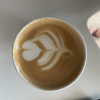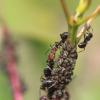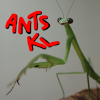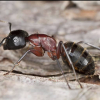- Formiculture.com
- Forums
- Gallery
- Members
- Member Map
- Chat

June 5 Jacksonville, FL queen (?) ID
Started By
RelientUKDr
, Jun 5 2021 11:59 AM

7 replies to this topic
#1
 Offline
-
Posted June 5 2021 - 11:59 AM
Offline
-
Posted June 5 2021 - 11:59 AM
Location (on a map) of collection: Jacksonville, FL
Date of collection: June 5, 2021
Length (from head to gaster): ~11mm
Distinguishing characteristics: petiole and post petiole
Distinguishing behavior: very active
Date of collection: June 5, 2021
Length (from head to gaster): ~11mm
Distinguishing characteristics: petiole and post petiole
Distinguishing behavior: very active
#2
 Offline
-
Posted June 5 2021 - 12:12 PM
Best Answer
Offline
-
Posted June 5 2021 - 12:12 PM
Best Answer
Pseudomyrmex gracilis queen.
- VoidElecent likes this
Ant Keeping & Ethology Discord - 2000+ Members and growing
Statesideants.com - order live ants legally in the US
#3
 Offline
-
Posted June 5 2021 - 12:13 PM
Offline
-
Posted June 5 2021 - 12:13 PM
i would say Pseudomyrmex gracilis queen
Edited by Antkeeper01, June 5 2021 - 12:14 PM.
1X Pogonomyrmex occidentalis 40-50 Workers
1X Solenopsis molesta 10 Workers (mono)
Ants I Want: Crematogaster sp, Camponotus Sp., Ponera Pennsylvanica, Mymercocystus sp.
My Youtube channel: https://www.youtube....kUjx-dPFMyVqOLw
Join Our Fledgling Discord Server https://discord.com/...089056687423489
#4
 Offline
-
Posted June 5 2021 - 6:56 PM
Offline
-
Posted June 5 2021 - 6:56 PM
YesPseudomyrmex gracilis queen.
Sent from my CPH2201 using Tapatalk
Young ant keeper with a decent amount of knowledge on local ant species.
YouTube: https://m.youtube.co...uKsahGliSH7EqOQ (It's pretty dead. Might upload again soon, don't expect my voice to sound the same though.)
Currently kept ant species, favorites have a star in front of their names (NOT in alphabetical order, also may be outdated sometimes): ★ Camponotus irritans inferior, ★ Ooceraea biroi, Pheidole parva, ★ Nylanderia sp., ★ Paraparatrechina tapinomoides, Platythyrea sp., Anochetus sp., Colobopsis sp. (cylindrica group), ★ Crematogaster ferrarii, Polyrhachis (Myrma) cf. pruinosa, Polyrhachis (Cyrtomyrma) laevissima, Tapinoma sp. (formerly Zatapinoma)
Death count: Probably over a hundred individual queens and colonies by now. I cannot recall whatsoever.
YouTube: https://m.youtube.co...uKsahGliSH7EqOQ (It's pretty dead. Might upload again soon, don't expect my voice to sound the same though.)
Currently kept ant species, favorites have a star in front of their names (NOT in alphabetical order, also may be outdated sometimes): ★ Camponotus irritans inferior, ★ Ooceraea biroi, Pheidole parva, ★ Nylanderia sp., ★ Paraparatrechina tapinomoides, Platythyrea sp., Anochetus sp., Colobopsis sp. (cylindrica group), ★ Crematogaster ferrarii, Polyrhachis (Myrma) cf. pruinosa, Polyrhachis (Cyrtomyrma) laevissima, Tapinoma sp. (formerly Zatapinoma)
Death count: Probably over a hundred individual queens and colonies by now. I cannot recall whatsoever.
#5
 Offline
-
Posted June 5 2021 - 6:57 PM
Offline
-
Posted June 5 2021 - 6:57 PM
She is semi claustral btw and I've heard the stings hurt like hell. You will need to feed her cricket legs or any small feeder insects and also honey. That should keep her alive.
Sent from my CPH2201 using Tapatalk
Sent from my CPH2201 using Tapatalk
- Antkeeper01 likes this
Young ant keeper with a decent amount of knowledge on local ant species.
YouTube: https://m.youtube.co...uKsahGliSH7EqOQ (It's pretty dead. Might upload again soon, don't expect my voice to sound the same though.)
Currently kept ant species, favorites have a star in front of their names (NOT in alphabetical order, also may be outdated sometimes): ★ Camponotus irritans inferior, ★ Ooceraea biroi, Pheidole parva, ★ Nylanderia sp., ★ Paraparatrechina tapinomoides, Platythyrea sp., Anochetus sp., Colobopsis sp. (cylindrica group), ★ Crematogaster ferrarii, Polyrhachis (Myrma) cf. pruinosa, Polyrhachis (Cyrtomyrma) laevissima, Tapinoma sp. (formerly Zatapinoma)
Death count: Probably over a hundred individual queens and colonies by now. I cannot recall whatsoever.
YouTube: https://m.youtube.co...uKsahGliSH7EqOQ (It's pretty dead. Might upload again soon, don't expect my voice to sound the same though.)
Currently kept ant species, favorites have a star in front of their names (NOT in alphabetical order, also may be outdated sometimes): ★ Camponotus irritans inferior, ★ Ooceraea biroi, Pheidole parva, ★ Nylanderia sp., ★ Paraparatrechina tapinomoides, Platythyrea sp., Anochetus sp., Colobopsis sp. (cylindrica group), ★ Crematogaster ferrarii, Polyrhachis (Myrma) cf. pruinosa, Polyrhachis (Cyrtomyrma) laevissima, Tapinoma sp. (formerly Zatapinoma)
Death count: Probably over a hundred individual queens and colonies by now. I cannot recall whatsoever.
#6
 Offline
-
Posted June 7 2021 - 5:09 AM
Offline
-
Posted June 7 2021 - 5:09 AM
They also need an extremely narrow nesting space. You could put straws in the test tube with one end against the wet cotton. Make sure the straws are not as long as the area between the wet cotton and the one blocking the entrance. That way the remainder of the space could be used as a sort of foraging area. Just an idea I came up with. It might not work.
#7
 Offline
-
Posted June 7 2021 - 5:02 PM
Offline
-
Posted June 7 2021 - 5:02 PM
They also need an extremely narrow nesting space. You could put straws in the test tube with one end against the wet cotton. Make sure the straws are not as long as the area between the wet cotton and the one blocking the entrance. That way the remainder of the space could be used as a sort of foraging area. Just an idea I came up with. It might not work.
You could also just push the cotton down further but make sure that the cotton is not tightly packed so that she can still breathe
#8
 Offline
-
Posted June 9 2021 - 3:58 AM
Offline
-
Posted June 9 2021 - 3:58 AM
They also need an extremely narrow nesting space. You could put straws in the test tube with one end against the wet cotton. Make sure the straws are not as long as the area between the wet cotton and the one blocking the entrance. That way the remainder of the space could be used as a sort of foraging area. Just an idea I came up with. It might not work.
That's a great idea! I'm going to get those really thin coffee stirrers and try that. Thanks!
0 user(s) are reading this topic
0 members, 0 guests, 0 anonymous users





















